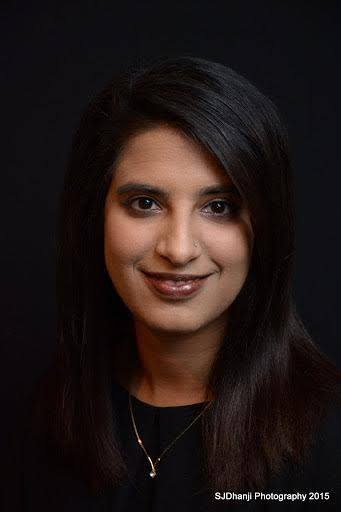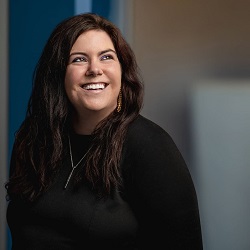Falling Into Fundraising: A Targeted Approach

In this new series “Falling Into Fundraising” Danisha Bhaloo-Shivji, manager of development and communications at the Boys & Girls Clubs Big Brothers Big Sisters of Edmonton & Area will interview women who are Black, Indigenous, or persons of color to talk about their careers as fundraisers, what we can do to showcase the profession as a viable, intentional career choice, and how to increase the number of BIPOC women in the profession.
In this interview with Allison Quintanilla Plattsmier, Ed.D., executive director of Edgehill Neighborhood Partnership and owner of the nonprofit consulting firm, AQP Consulting, she talks about why she became a fundraiser, the difference between fundraising and philanthropy, and systemic changes needed within the philanthropic sector.
What motivated you to get into fundraising?
My parents instilled in me the importance of serving others from a young age. I remember growing up volunteering on the weekends and participating in church mission trips. However, at the age of sixteen, I clearly remember the moment I knew what I wanted to do as a career. I saw a Diana DeGarmo benefit concert on TV. I thought if someone only a little older than I was at the time could make such an impact through their platform, why couldn't I do something similar? I knew my purpose in life was to impact the lives of others, so I became hungry for every opportunity to do so.
I found an opportunity to serve as a team leader for the Tennessee Kidney Foundation's Gift of Life walk. I served as a team leader in the school challenge. I remember walking around the school getting pennies here, a nickel there, and small bills from teachers. By the end of the month, I believe we had raised a little over $1,300, and I remember feeling like that was such a monumental amount of money. When I met a young girl my age who needed a kidney transplant, who was also serving as a team leader, I knew what a big difference that money would make in helping her get the care she needed. The whole process was truly transformative, and I began searching for every opportunity to engage in fundraising moving forward.
At the start of your career, you formalized your education and learning in the social impact sector. Can you share more with us about what that looked like and the impact your education has had on your career?
I consider myself a lifelong learner. I have always said, ‘If I don't know it now, I will learn it.’ Additionally, as a young Latina, I knew I would have to work 10 times as hard to be measured on equal footing, so I did everything to establish credibility through my higher education pursuits and certifications.
My first degree was a B.S. in Political Science: Public Administration and Nonprofit Management from the University of Tennessee at Chattanooga. It was very theory-based, and I wanted something that gave me a little more hands-on experience and looked at things from a more systemic lens. This led me to pursue my Master of Education in Community Development and Action at Vanderbilt University. This program focused on systemic inequality and mobilizing communities to mitigate these systemic factors while engaging in social impact work. During this program, I heard numerous stories about gender and age discrimination experienced by my colleagues in the sector. From there, I enrolled at Trevecca Nazarene University in their Doctor of Education in Leadership and Professional Practice program. I conducted my dissertation on the effects of perceived age and gender discrimination on hiring, retention and upward mobility in the nonprofit sector.
In addition to my undergraduate and graduate work, I have obtained several certifications, including my CFRE, in areas related to human resources, leadership and advocacy, legal and ethical decision-making, and much more. Pursuing education through all these mediums has helped me to see fundraising through so many different lenses. It has been enlightening to see the various ways we are taught how to be fundraisers while simultaneously experiencing the real-life, hands-on development of learning how to be a fundraiser since I was working full-time while also completing my education and other professional development.
You have held many roles in mostly smaller organizations where fundraising was part of the role. Can you share how various functions within an organization are intertwined, for example, an executive director vs. a fund development role?
Yes, I have often worn most of the hats within my organization—working as the executive director, who is also the fundraiser, marketer, program or financial manager, human resources, and more. I have also led teams ranging in size from three to nine, but I have never had the chance to work with an entire development department. That is another reason I pursued an education in so many different areas—I needed all the different skills if I ever needed to be a one-woman show.
However, I always said I could never hold an executive director role where I didn't have the opportunity to be heavily involved in fundraising, as that is where my real passion lies. I believe fundraising/development is the one role that touches every aspect of the organization. It is highly correlated with programming and the outcomes and objectives that guide the programming. It is integrated with the messaging of the organization, its brand and reputation, and how we communicate with constituents. Our decisions within fundraising are heavily tied to both revenue and expenses and are, therefore, an essential aspect of financial management. Ultimately, the best and most successful organizations can cohesively integrate these departments to build off each other and create synergy versus operating in silos.
You've thought a lot about philanthropy. Share with us the difference between fundraising and philanthropy and some of the systemic changes needed in the philanthropic sector.
To me, fundraising is the activity, but philanthropy is the system. An analogy that I use is: fundraising is to philanthropy as prayer is to faith. It is a tool you can use to advance your overall philanthropic mission. In Greek, philanthropy means "love for humanity." It is often viewed as strategic giving that invests in infrastructure and develops systems that will advance human needs or solve problems in society. This is usually done through longer-term investment and major gifts.
However, when we look at many of the most notable philanthropists, it is a white-dominated space. Many philanthropists made their fortunes on the backs of people of color, but their wealth distributions rarely make it back to communities of color because their boards are predominately white. According to The Harvard Gazette, the racial wealth gap represents over four centuries of institutional and systemic racism that has led to a current reality where the net wealth of a typical Black family in America is around one-tenth that of a white family. This gap has only continued to widen in the face of the economic fallout of the COVID-19 pandemic which has had a disproportionate effects on communities of color. When it comes to ensuring philanthropic funds make it to communities of color, leaders of color are often at a disadvantage across four key areas: getting connected to funders, building rapport, securing support, and sustaining relationships. These disadvantages are the result of white-led foundations and the biases they bring to the process.
We also need to look at the biases of those who work in the fundraising profession. Because of the racial wealth gap, many fundraisers tend to focus a lot of their prospect research on white donors. However, despite the racial wealth gap, Black households give away 25% more of their income per year than whites, and 63% of Latino households now make charitable donations. As of 2021, the W.K. Kellogg Foundation and Rockefeller Philanthropy Advisors reported that Black families are responsible for over $11 billion in contributions every year.
As many organizations are discussing their commitment to anti-racism, I have heard many boards express fear of alienating donors should they adopt an external anti-racist message. But we have to ask ourselves, who are we trying to court? If committing to dismantle white supremacy and uplift Black and Brown voices alienates your donors, are those the type of donors you want to cultivate and steward? As Kia Jarmon, agency director for a boutique communications and community engagement firm, MEPR Agency, has counseled, you have to ask yourself what you are willing to lose and what power you are willing to cede in your anti-racist journey? Kia is also the founder and visionary for the Nonprofit Equity Collaborative that provides capacity building support and leadership development to nonprofits led by people of color, and co-leader of the Black Philanthropy Initiative in Nashville.
We can change the landscape of philanthropy and shift the way dollars are flowing both from and to communities of color in an impactful way if we only take the time to acknowledge the systems that created our current landscape and commit to dismantling it.
As a woman of color in philanthropy, what are your aspirations for the future of fundraising in a post-pandemic world? Both personally and for all women fundraisers?
I have aspirations for a complete overhaul of our culture of philanthropy. But on a more micro level, I would love to see more inclusivity for parents in the workforce, particularly moms. Our parental leave benefits are abysmal, and a lot of nonprofit organizations are not large enough, so they are not required to offer either paid or unpaid options for new parents. Women are typically forced to return much earlier than they are physically or emotionally ready to, which leads to stress and, if they are trying to breastfeed, can hinder their breastfeeding journey. During the pandemic, we've also seen that most of the caregiving responsibilities fell on women during this time. When daycares and schools shut down, it was women who were expected to pick up the slack while maintaining their job.
This even led many women to step out of the workforce due to a lack of options. So I think that is one deeply personal and significant gap I currently see. I would love to see a future where women are empowered to be both employees and moms and supported in a way where they feel equally fulfilled in both roles.
Additionally, from an equity perspective, I would love to see more sponsorship of women who are Black, Indigenous or persons of color. We talk a lot about mentorship in the sector, but sponsorship is equally, if not more, important. White peers have to be willing to cede power and use their privilege to open doors for their colleagues of color. It will take them being willing to give up their seats at the table to truly create space for BIPOC women and allow them to thrive to their full potential.
Finally, I challenge more funders to take a deep dive into both their application and review process and think critically about how they may introduce bias into the process. Also, think about how they can remove barriers that may be creating a significant disadvantage for nonprofits led by people of color and nonprofits serving communities of color.


 Danisha is a Certified Fund Raising Executive and works as the development and communications manager with Boys & Girls Clubs Big Brothers Big Sisters of Edmonton. In a volunteer capacity, Danisha is the chairperson of the Social Wellbeing Advisory Committee for the City of Calgary, a member of the Women's Impact Council for the Association of Fundraising Professionals (Global), and is a board member for United Way Centraide Canada. She also sits on the local United Way of Calgary’s Leader’s Cabinet and is the co-chair of Women United with United Way of Alberta Capital Region. Danisha has been recognized for her contributions to the community by Future of Good as one of their 21 Young Impact Leaders, the Government of Alberta Stars of Alberta Award, University of Alberta Alumni Award, Avenue Magazine Edmonton’s Top 40 under 40, Edmontonians' Magazine’s Sizzling 20 under 30, and Correctional Services of Canada.
Danisha is a Certified Fund Raising Executive and works as the development and communications manager with Boys & Girls Clubs Big Brothers Big Sisters of Edmonton. In a volunteer capacity, Danisha is the chairperson of the Social Wellbeing Advisory Committee for the City of Calgary, a member of the Women's Impact Council for the Association of Fundraising Professionals (Global), and is a board member for United Way Centraide Canada. She also sits on the local United Way of Calgary’s Leader’s Cabinet and is the co-chair of Women United with United Way of Alberta Capital Region. Danisha has been recognized for her contributions to the community by Future of Good as one of their 21 Young Impact Leaders, the Government of Alberta Stars of Alberta Award, University of Alberta Alumni Award, Avenue Magazine Edmonton’s Top 40 under 40, Edmontonians' Magazine’s Sizzling 20 under 30, and Correctional Services of Canada. Allison Quintanilla Plattsmier, Ed.D, has over 10 years of experience in the nonprofit sector. She currently serves as executive director of Edgehill Neighborhood Partnership and runs her own nonprofit consulting firm, AQP Consulting. A Nashville native, she has been at the forefront of issues such as the affordable housing crisis, the transit referendum, and the city’s urban planning and infrastructure design through the creation of Nashville’s first art park, William Edmondson Park. A sought-after diversity, equity, and inclusion practitioner, she is a vocal advocate for gender parity, closing the wage gap, and ending the motherhood penalty. With accolades such as Nashville’s Top 30 Under 30, NBJ’s 40 Under 40, Diversity MBA’s Top 100 Under 50 Executive Leaders, a two-time ALPFA Scholar, 2021 National Latino Leader, and the National Association of Female Executives’ 2019 Rising Star, Dr. Quintanilla Plattsmier is a true leader in the Middle Tennessee community.
Allison Quintanilla Plattsmier, Ed.D, has over 10 years of experience in the nonprofit sector. She currently serves as executive director of Edgehill Neighborhood Partnership and runs her own nonprofit consulting firm, AQP Consulting. A Nashville native, she has been at the forefront of issues such as the affordable housing crisis, the transit referendum, and the city’s urban planning and infrastructure design through the creation of Nashville’s first art park, William Edmondson Park. A sought-after diversity, equity, and inclusion practitioner, she is a vocal advocate for gender parity, closing the wage gap, and ending the motherhood penalty. With accolades such as Nashville’s Top 30 Under 30, NBJ’s 40 Under 40, Diversity MBA’s Top 100 Under 50 Executive Leaders, a two-time ALPFA Scholar, 2021 National Latino Leader, and the National Association of Female Executives’ 2019 Rising Star, Dr. Quintanilla Plattsmier is a true leader in the Middle Tennessee community. 
